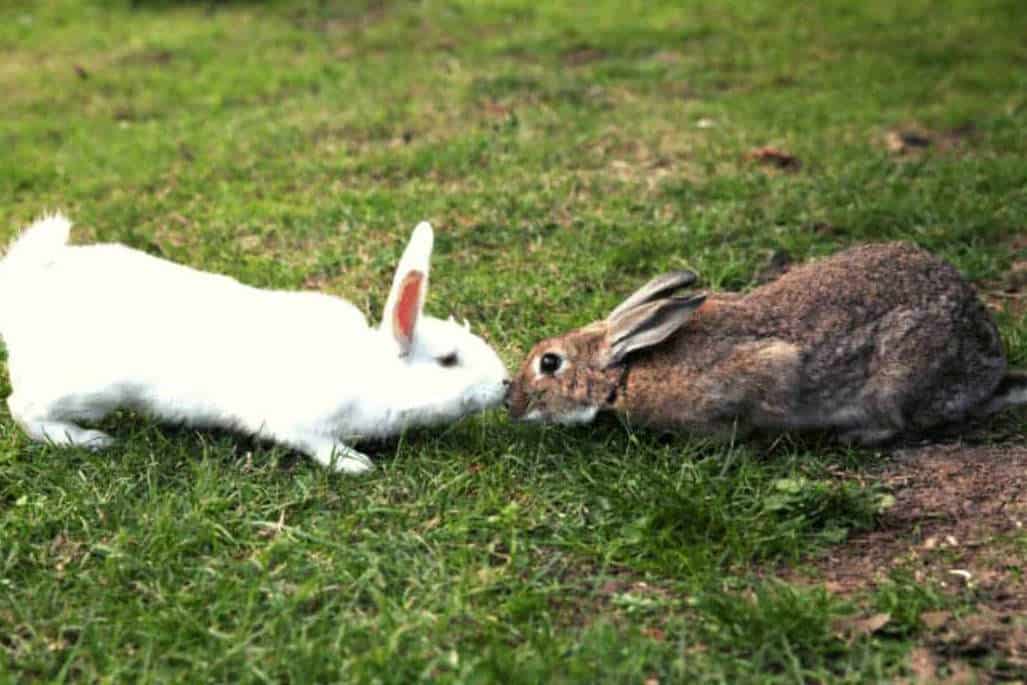What comes to your mind when you see a rabbit?
Rabbits are generally known to be cute, kind, and fluffy creatures. However, they can become aggressive quickly when anything threatens their safety. The change from cute to aggressive can be swift and dramatic!
In this article, we’ll look at the top six aggressive rabbit breeds you should know, how to spot signs of aggression, and how to manage these aggressive creatures. Let’s get started.
Signs of Aggression in Rabbits

1. Fear
One of the primary reasons why rabbits become overly aggressive is fear. When faced with a dangerous situation, like a predator coming at them, they either run away or attack aggressively.
Also, they don’t relate well with unfamiliar human beings trying to touch any part of their body.
2. Food Protection
Most rabbits protect their food, especially when they live with other rabbits or wild predators. They may want to prove dominance and social hierarchy to other creatures by protecting their food by any means possible.
They can become aggressive when they see you near their food source.
3. Hormonal Changes
Most rabbits breed during the spring, so they become very aggressive and dispassionate when experiencing severe hormonal changes. They have intense nesting and pregnancy instincts and become aggressive to protect their unborn offspring.
So, try and stay off a breeding rabbit to avoid issues.
4. Territorial Behavior
Have you ever tried to reach out for a rabbit’s food or water in its cage and been massively attacked? It’s an instinctual behavior. Most rabbits do everything to protect their territory from intruders, especially the males. These rabbits feel you’re invasive and jump at you immediately.
5. Pain
Pain causes rabbits to become aggressive or violent, especially if they’ve lingered with it for too long. If your kind and friendly pet rabbit suddenly becomes aggressive, and you can’t figure out why from the above reasons, it’s most likely in pain.
Top 6 Aggressive Rabbit Breeds
1. Holland Lop

The Holland lop is named such because of its lopped ears, its most unique feature. It’s a common breed in the US and UK because most people there appreciate its size. They don’t occupy much space, are not costly to raise or train, and don’t eat much food.
This rabbit breed is also one of the world’s smallest, weighing between 2 to 4 pounds on average. So if you are looking for a rabbit that remains small in size, here you have it.
Their size allows them to avoid most impending dangers, like hiding themselves from predators by squeezing into a small hole.
However, if you think you can intrude on its privacy or try to discomfort it in any way because you feel it won’t react, you’re sorely mistaken! This rabbit can become incredibly uncomfortable and aggressive when irritated or in pain.
2. Lionhead

Oh, don’t let the name scare you! Lionhead rabbits are among the kindest and friendliest breeds you can ever raise.
This breed is named so because it has lion-like furs around its face. It also has a wooly mane around its body and comes in varying colors. They originated from Belgium, and people introduced this breed to the US in 1998, so it’s safe to say that it’s relatively newer than its counterparts. Like the Holland lop, they are also small and fuzzy.
This breed is often mild but can quickly become aggressive when triggered. It’s incredibly territorial and loves to protect its food, water, or whatever it possesses. It doesn’t matter if the predator or invader is bigger than them; they face them head-on. They also have excessive energy.
People attribute this trait to their lion-like appearances, but who knows?
3. Flemish Giant

Unlike the Holland Lop or the Lionhead, the Flemish Giant is a huge rabbit breed. It may not be as tiny, cute, and fluffy as others, but it’s a great cuddle bunny. I’m just saying!
Would you believe that this breed is the world’s largest and oldest? Yes, it is. It has been around since the 18th century and has always been popular. It weighs about 15 pounds on average, but the male can weigh as much as 22 pounds and the female, 20 pounds if they are raised in the right environment.
They may look lighthearted, friendly, and social, but it’s a facade. They’re one of the most aggressive rabbit breeds. They are territorial, making them cautious of predators or intruders. They bite intruders once they sense anything dangerous. You may think their large size reduces their energy, but you’re mistaken. They’re super energetic!
4. Checkered Giant

Are you looking for a great family pet? Here is your answer!
However, it consumes a lot of food and needs ample space. These factors make it typically more expensive to train than other breeds.
The checkered giant is super large. If you want to identify this rabbit, simple! Look out for distinctive markings, broad ears, and a wide head.
They also have long, powerful legs. The typical checkered giant has a nice medium-sized soft coat. Because of this, they don’t need as much grooming as their mates do.
The checkered giant is friendly and social, but don’t take this trait for weakness or you’ll regret it. Like other rabbits, they are territorial. They dislike external parties invading their private spaces.
5. Tan Rabbit

The tan rabbit is called the “Aristocratic Fancy” for a reason. It’s one of the few rabbit breeds that ooze elegance, class, and exclusivity.
Breeders created the tan rabbit from breeding both wild and domestic species over the years. This species has been around for a long time (since the 60s) but have only become popular recently. Why is this rabbit sophisticated, you may ask?
It’s a small, gorgeous rabbit breed with distinctive features. It has a sleek body shape, glossy coat, large standing ears, sophisticated erect pose, and an energetic personality. Their coats come in these four colors- black, lilac, blue, and chocolate. The tan rabbit is very alert and active.
While tan rabbits are friendly, they aren’t very warm and compassionate. They enjoy people playing with them but hate people touching them for long. They attack immediately when they want their space and an external body wants to violate their privacy.
6. Belgian Hare

Another fancy rabbit breed is the Belgian hare. It’s been around in the US since 1877 and was so famous that it began several domestic rabbit movements all over the country.
This rabbit breed is so named because it has physical features similar to a hare. It has a delicate, slender body with a well-arched back and loins.
While they are typical domestic rabbit breeds, they often have chestnut coats with markings that make them look like wild breeds. They have better sizable heads than most domestic breeds, so if you see it in the open, you may judge it as a wild breed.
If you see a Belgian hare, you would fall in love. They are very bubbly, jovial, and strong. However, they are not suitable pets because they can become overly aggressive, especially if you live with children or elderly people.
This doesn’t mean you can’t keep them as pets. While they can be challenging, Belgian Hares can often adapt and become familiar with household members. However, they may randomly attack strangers.
Managing Aggressive Rabbits

Now that you know the top 6 aggressive breeds to look out for, how can you manage them?
1. Training and Socialization
If you want to raise a pet bunny, ensure you train it in the most peaceful way possible. Don’t punish your rabbit or use extreme methods on it because it may sense those measures as threats and act aggressively. If it’s not getting something right, give it some time.
Regularly interact with them and pet them to foster trust.
2. Avoiding Aggressive Behaviors
Once you notice that a specific action makes your rabbit aggressive, stop doing that immediately. For instance, rabbits hate getting scared or startled. Instead of opening and hitting the door or shuffling your feet on the floor, try doing everything lightly.
3. Establish a Safe Environment.
An excellent way to prevent rabbit aggression is to make the rabbit feel safe and spaced. What does this mean?
Rabbits love to feel safe as much as humans do. Once they sense any threat, their instincts push them to attack, regardless of their form. Don’t do anything that threatens their existence.
Also, create ample space for them to move and thrive, especially when raising them indoors. Their cage and room should be big enough to contain them.
What Do I Do When the Rabbit’s Aggression is Beyond My Control?
It’s time to talk to a vet. Sometimes you can read a thousand books or watch a dozen videos, but you wouldn’t identify what’s wrong with your rabbit. It will keep pouncing and biting people all day long, and you will wonder if something is wrong with your training methods.
Several vets are available to choose from, but the truth is, you must choose one with the right experience. When selecting a vet, go for one with the right experience and qualifications.
Final Words
So there you have it! After learning about these top six aggressive rabbit breeds and their warning signs, you can now identify them in a heartbeat.